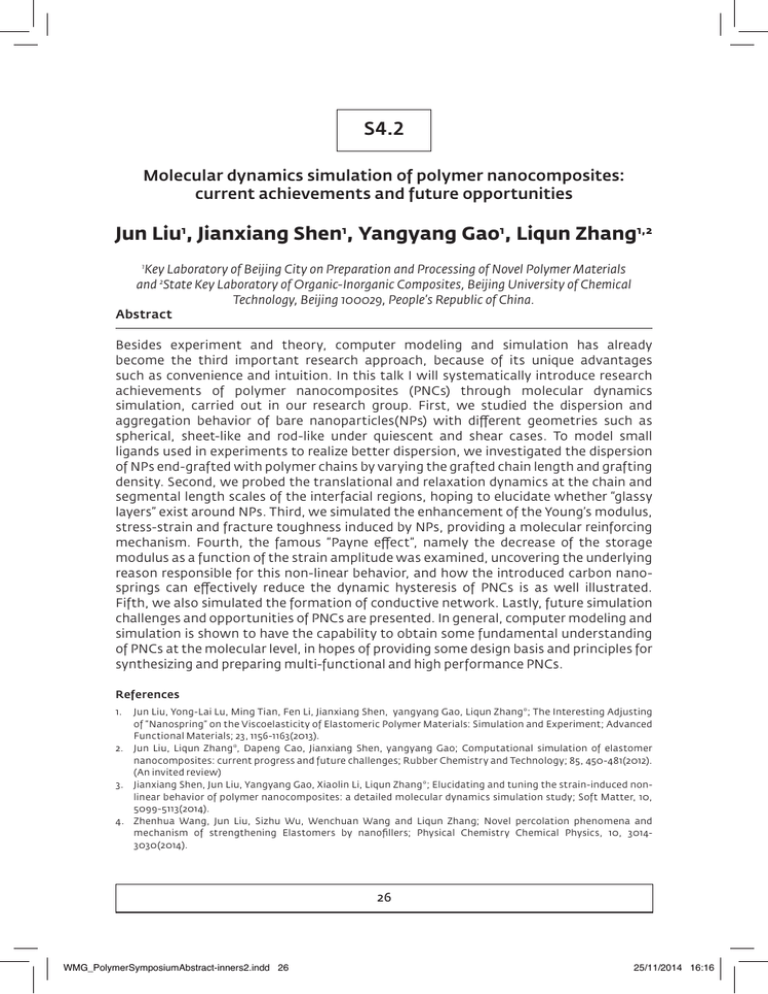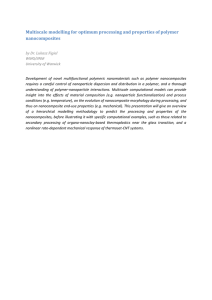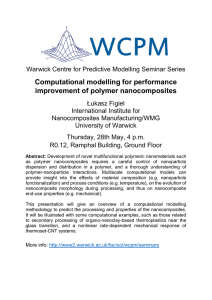S4.2
advertisement

S4.2 Molecular dynamics simulation of polymer nanocomposites: current achievements and future opportunities Jun Liu1, Jianxiang Shen1, Yangyang Gao1, Liqun Zhang1,2 1 Key Laboratory of Beijing City on Preparation and Processing of Novel Polymer Materials and 2 State Key Laboratory of Organic-Inorganic Composites, Beijing University of Chemical Technology, Beijing 100029, People’s Republic of China. Abstract Besides experiment and theory, computer modeling and simulation has already become the third important research approach, because of its unique advantages such as convenience and intuition. In this talk I will systematically introduce research achievements of polymer nanocomposites (PNCs) through molecular dynamics simulation, carried out in our research group. First, we studied the dispersion and aggregation behavior of bare nanoparticles(NPs) with different geometries such as spherical, sheet-like and rod-like under quiescent and shear cases. To model small ligands used in experiments to realize better dispersion, we investigated the dispersion of NPs end-grafted with polymer chains by varying the grafted chain length and grafting density. Second, we probed the translational and relaxation dynamics at the chain and segmental length scales of the interfacial regions, hoping to elucidate whether “glassy layers” exist around NPs. Third, we simulated the enhancement of the Young’s modulus, stress-strain and fracture toughness induced by NPs, providing a molecular reinforcing mechanism. Fourth, the famous “Payne effect”, namely the decrease of the storage modulus as a function of the strain amplitude was examined, uncovering the underlying reason responsible for this non-linear behavior, and how the introduced carbon nanosprings can effectively reduce the dynamic hysteresis of PNCs is as well illustrated. Fifth, we also simulated the formation of conductive network. Lastly, future simulation challenges and opportunities of PNCs are presented. In general, computer modeling and simulation is shown to have the capability to obtain some fundamental understanding of PNCs at the molecular level, in hopes of providing some design basis and principles for synthesizing and preparing multi-functional and high performance PNCs. References 1. Jun Liu, Yong-Lai Lu, Ming Tian, Fen Li, Jianxiang Shen, yangyang Gao, Liqun Zhang*; The Interesting Adjusting of “Nanospring” on the Viscoelasticity of Elastomeric Polymer Materials: Simulation and Experiment; Advanced Functional Materials; 23, 1156-1163(2013). 2. Jun Liu, Liqun Zhang*, Dapeng Cao, Jianxiang Shen, yangyang Gao; Computational simulation of elastomer nanocomposites: current progress and future challenges; Rubber Chemistry and Technology; 85, 450-481(2012). (An invited review) 3. Jianxiang Shen, Jun Liu, Yangyang Gao, Xiaolin Li, Liqun Zhang*; Elucidating and tuning the strain-induced nonlinear behavior of polymer nanocomposites: a detailed molecular dynamics simulation study; Soft Matter, 10, 5099-5113(2014). 4. Zhenhua Wang, Jun Liu, Sizhu Wu, Wenchuan Wang and Liqun Zhang; Novel percolation phenomena and mechanism of strengthening Elastomers by nanofillers; Physical Chemistry Chemical Physics, 10, 30143030(2014). 26 WMG_PolymerSymposiumAbstract-inners2.indd 26 25/11/2014 16:16 Short Biography Jun Liu is an associate professor in the department of Materials Science and Engineering of Beijing University of Chemical Technology, and he mainly focuses on simulating the structure, dynamics, static and dynamic mechanical properties of polymer nanocomposites through molecular dynamics simulation. He has published over nearly twenty peer reviewed papers, such as Advanced Functional Materials, Macromolecules, Soft Matter, Langmuir and so on. 27 WMG_PolymerSymposiumAbstract-inners2.indd 27 25/11/2014 16:16



